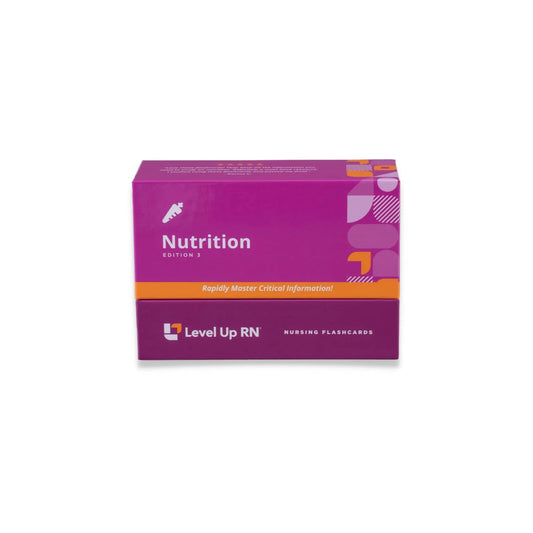When you see this Cool Chicken, that indicates one of Cathy's silly mnemonics to help you remember. The Cool Chicken hints in these articles are just a taste of what's available across our Level Up RN Flashcards for nursing students!
Welcome to our overview on fat-soluble vitamins (Vitamin A, D, E, & K). This series follows along with our Nutrition Essentials for Nursing Flashcards which are intended to help RN and PN nursing students study for nursing school exams, including the ATI, HESI, and NCLEX.
Nutrition plays a key role in patient wellness, and patient teaching regarding nutrition is a key part of EVERY nurse’s job. These flashcards will help you understand the basics of nutrition, along with key nutritional and lifestyle considerations for common health disorders.
Nutrition Essentials - Nursing Flashcards
Vitamin A
Vitamin A plays a number of important functions in the body, like supporting vision, immune function, and cell growth.
Vitamin A sources
You can find vitamin A in a variety of food sources, including orange and yellow vegetables and fruits.
Carrots are the orange vegetable that everyone seems to know has vitamin A! And it's true. Carrots are orange and they are rich in vitamin A, and they do support vision.
Other orange or yellow vegetables or fruits include sweet potatoes, cantaloupe and mango—all rich in vitamin A as well.
You can also find vitamin A in fish, liver, dairy, and eggs.
Vitamin A deficiency
If your patient has a deficiency in vitamin A, it can cause a condition called xerophthalmia.
Xerophthalmia
Xerophthalmia is a condition of the eye that can cause night blindness, drying of the cornea, and drying of the conjunctiva.
Vitamin A toxicity
Vitamin A toxicity can cause an increase in intracranial pressure. It can cause nausea, headache, joint pain, coma, liver damage, and birth defects in a developing fetus.
Vitamin D
Vitamin D is critical for bone growth and remodeling because it increases calcium absorption, and it also helps to decrease inflammation in the body.
Vitamin D sources
A key source of vitamin D is the sunlight. If you have a patient who is inside all the time and doesn't get any sun, chances are they may be deficient in vitamin D and may require supplementation.
Other sources of vitamin D include food sources such as fatty fish, fish oil, and fortified foods. Often, milk or cereals are fortified with vitamin D, and that helps to increase an individual's intake of that vitamin.
Vitamin D deficiency
A vitamin D deficiency can result in rickets in children and osteomalacia in adults.
Rickets
Rickets is a disorder of bone loss due to vitamin D deficiency. Signs and symptoms of Rickets include decreased bone density, developmental delays, seizures, and skeletal deformity.
Studying rickets in nursing school or for the ATI, HESI, or NCLEX? Rickets is one of the key pediatric health alterations covered in our Pediatric Nursing Flashcards.
Osteomalacia
Osteomalacia is a disorder of bone loss due to vitamin D deficiency—the adult equivalent of rickets. Osteomalacia is also characterized by bone deformities as well as bone pain and seizures.
Vitamin D toxicity
Toxicity associated with excess vitamin D is always a risk because it's a fat soluble vitamin and stored in the body for a long period of time.
Signs and symptoms of vitamin D toxicity can include hypercalcemia, nausea and vomiting, muscle weakness, and dehydration.
Vitamin E
Vitamin E plays a number of important functions in the body: it acts as an antioxidant, it helps to support immune function and it also supports metabolism.
Vitamin E sources
You can find vitamin E in foods such as seeds, nuts, vegetable oil, and green leafy vegetables.
Vitamin E deficiency
If you have a deficiency in vitamin E, this can cause peripheral neuropathy as well as ataxia, which is impaired balance and coordination.
A lack of vitamin E can also cause a decrease in immune function.
Vitamin E toxicity
Vitamin E toxicity can impair blood coagulation, which would increase a patient's risk for bleeding.
 Too much E = blEEding.
Too much E = blEEding.
Vitamin K
Vitamin K is another fat-soluble vitamin that is important for blood clotting as well as bone maintenance.
Vitamin K sources
You can find vitamin K in a variety of foods including green leafy vegetables like broccoli, kale, and collard greens. You can also find it in vegetable oil and soybeans.
Vitamin K deficiency
A deficiency in vitamin K places someone at increased risk for bleeding, because vitamin K is an essential component of the coagulation cascade. If you don't have enough vitamin K, your blood won't clot effectively and you will have increased risk of bleeding.
Vitamin K toxicity
There's a lower potential for toxicity with vitamin K than with the other fat-soluble vitamins.
However, if you have a patient who is on warfarin, which is an anticoagulant that works by antagonizing vitamin K, then it's going to be important for that patient to maintain a consistent intake of vitamin K. If this patient suddenly increases their intake of vitamin K, the warfarin won't be as effective at its anticoagulation.
If they suddenly decrease their intake of vitamin K, then they will be at risk for bleeding.



2 comments
CATHY THE BEST EVER
KEEP IT UP
Thanks Cathy! You’re the best!